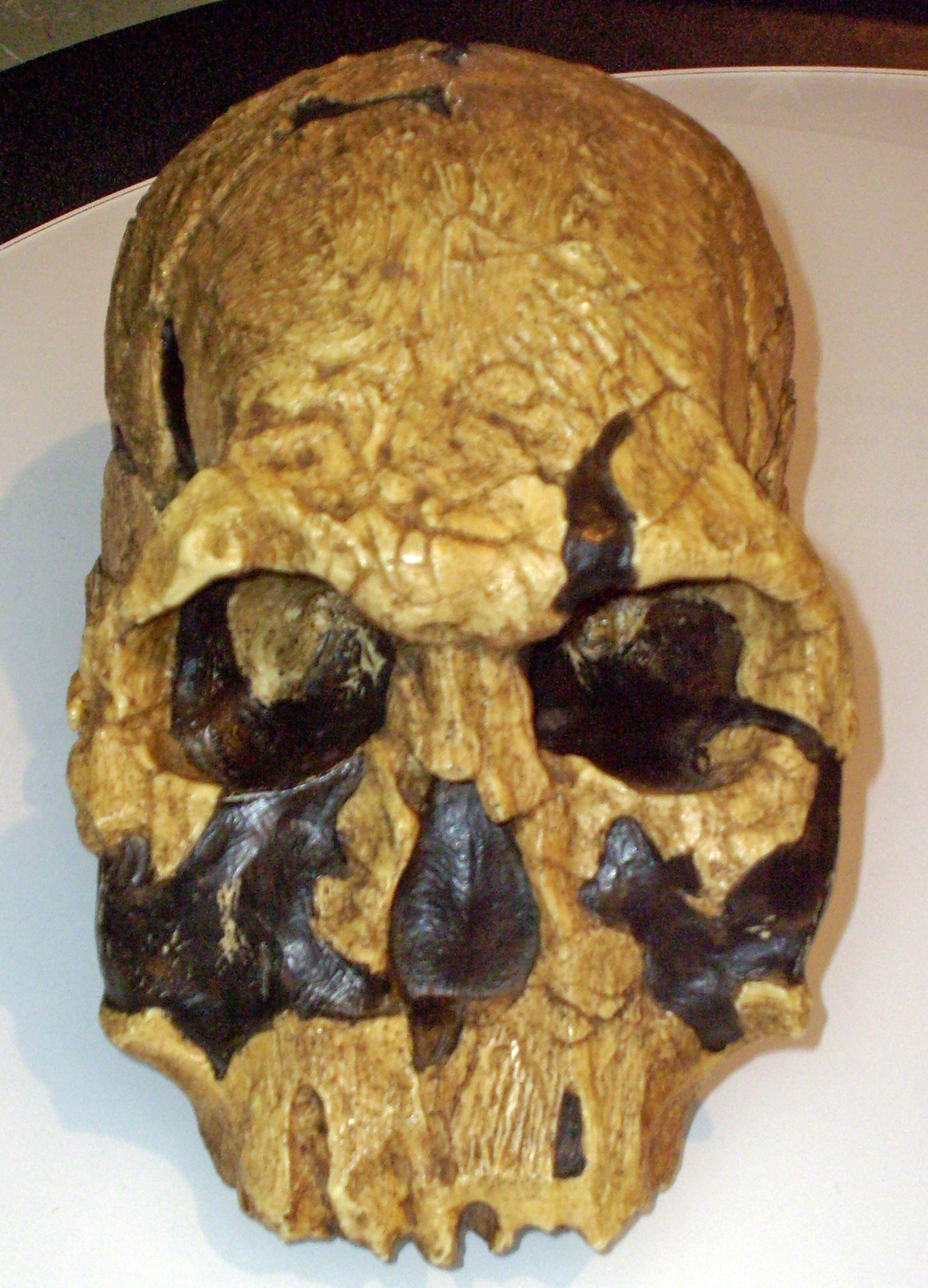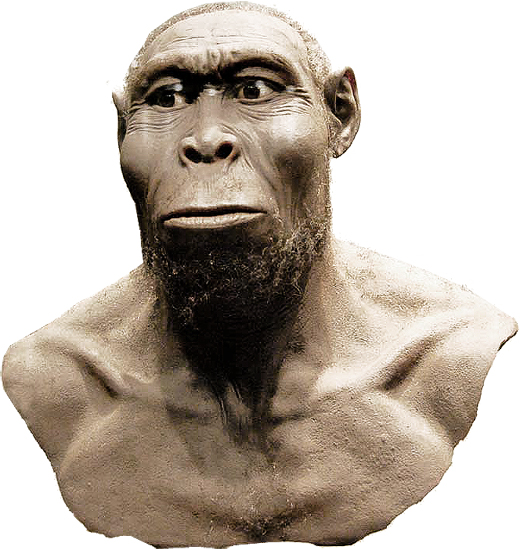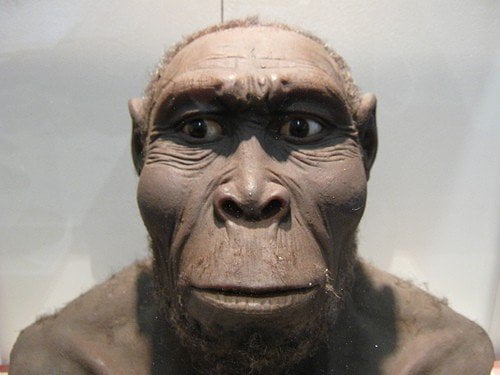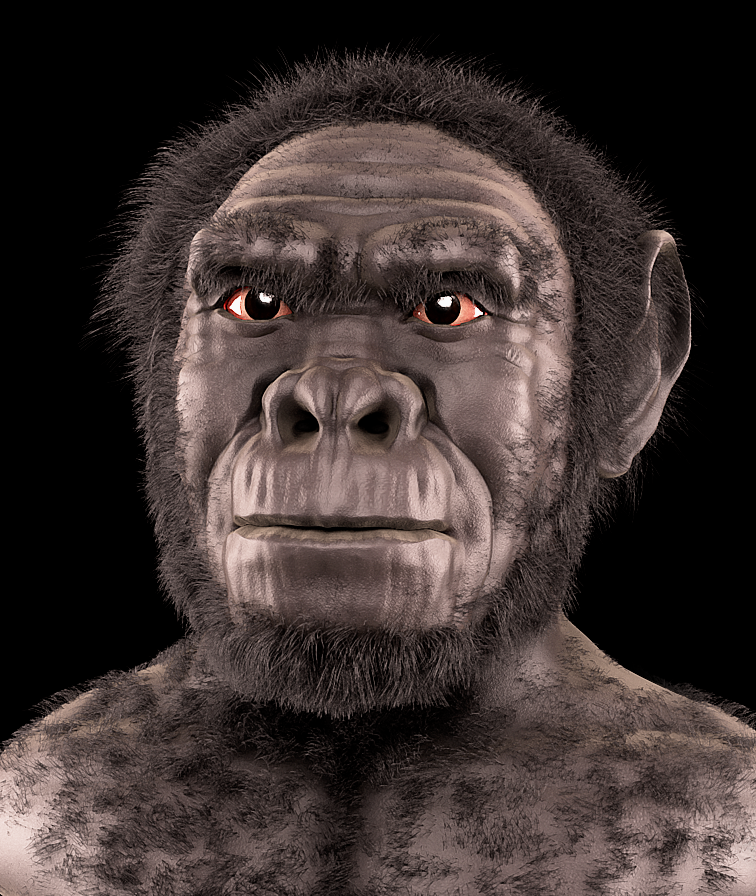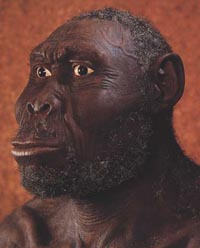Homo rudolfensis
Replica of the skull of KNM ER 1470
- Kenya, Malawi
Homo rudolfensis is an extinct species of the genus Homo. Considered the most original so far described species of this genus.
The overall modest number of finds has meant that because of the time and morphological proximity to the australopithecines also the name Australopithecus was proposed rudolfensis, and also the names Kenyanthropus rudolfensis ' (because of the potentially extremely flat facial skeleton; cf. Kenyanthropus platyops ) and, Pithecanthropus rudolfensis ' ( hypothetical based on Haeckel's original man, Pithecanthropus primigenius '). "Despite the incomplete findings, however, there is little doubt that Homo rudolfensis part of the lineage of man. "
Naming
The name of the genus Homo is derived from the Latin homo [ hɔmo ː ] "man." The epithet rudolfensis refers to the site on the Lake Rudolf (now Lake Turkana ) in Kenya. Homo rudolfensis therefore means " man from Lake Rudolf ."
Finds and age
Type specimen is a 1972 under the direction of Richard Leakey at Koobi Fora by Bernard Ngeneo found, strongly scraped and toothless skull excluding the mandible with the catalog number KNM -ER 1470 skull This was initially attributed to an age of 2.6 million years ago.; later measurements corrected this figure to 1.9 million years ago. From its discoverers the Fund was initially made no kind named by then, but merely assigned to the genus Homo. In 1986 the skull was reported in a publication by Valerii Alexeev as Homo rudolfensis.
Whether the characteristics of the fossil KNM -ER 1470 were characteristic of its entire population or only a specific feature parameters within a form- rich nature, could not immediately be clarified. It was not until the 2012 published finds of the maxilla KNM -ER 62000 and the partially edentulous mandible KNM -ER 60000 brought clarity here by showing that a plurality of mutually very similar individuals exist.
Of custody of the finds is the Kenyan National Museum in Nairobi; MSM stands for the museum, ER for East -Rudolf, the eastern shore of Lake Turkana.
Further finds that Homo rudolfensis be attributed, were made very close to the type specimen ( KNM -ER of the mandibular 1802) and in Ethiopia ( Omo region ) and Malawi. In Malawi, the German paleoanthropologist Friedemann Schrenk found in 1991 a lower jaw (UR 501), for an age of 2.5 million years has been calculated. Due to this dating applies Homo rudolfensis as the oldest representative of the genus Homo.
Why the species is extinct, is not known.
Features
The brain volume of H. rudolfensis is about 750 cc; the arrangement of the teeth in the upper and lower jaw and the shape of both jaws similar in many respects to that of Paranthropus. Since the skull findings were heavily fragmented, initially remained unclear whether the rather long face and the mandibular prognathic ( projecting forward ) or more orthognathic (vertical) were arranged; a Überaugenwulst does not exist. Only the maxilla KNM -ER 62000, which includes the palate bone and the anterior facial bones have been preserved, confirmed the pronounced orthognathic and shows striking similarities with the KNM -ER 1470; originating from the same era and Homo habilis ascribed findings, however, are clearly prognathous. The well-preserved mandible KNM -ER 60000 is derived from another individual, but "fit" principle for KNM -ER 1470 due to its arc shape and therefore of the same kind was attributed.
So far, no coherent skeletal remains of Homo rudolfensis were known, so that his body is unsecured below the head. However, a wealth of individual limb bones as well as a pool ( archive number LMN -ER 3228 ) was discovered in the same Fund layers, which significantly differ from Australopithecus finds, and more closely resemble those of modern humans. Should these findings to Homo rudolfensis part ( which is probably the sense that so far no other dental or skull finds from these layers are known, which could belong to a parallel existing species of the genus Homo ), then " stood the species often and over longer time away upright ". The body size of KNM -ER 1472 and KNM -ER 1481 would have amounted to almost 150 cm, body weight about 50 kg; for the femur KNM -ER 3728 would result in the reconstruction of the complete individual, a body height of 145 cm and a weight of 45 kg.
In direct connection with Fund fossils of Homo rudolfensis far no stone tools were discovered, but in slightly younger Fund horizons at the west Lake Turkana. Therefore, it is not certain, but is considered possible that Homo rudolfensis the first Homininus was, who used stone tools. Because of dental studies, it is believed that Homo rudolfensis "predominantly herbivores " was. Associated finds ( including relatives of gazelles, elephants and jackals, but also of hippos and baboons ) suggest that the habitat of Homo rudolfensis had a varied mix of open, savanna -like grasslands and gallery forests with dense undergrowth.

